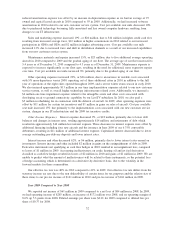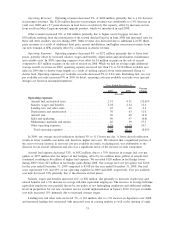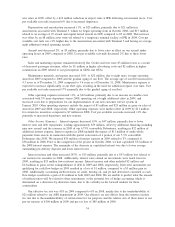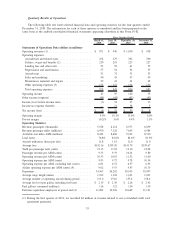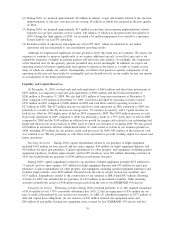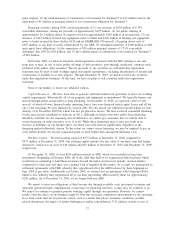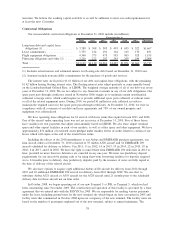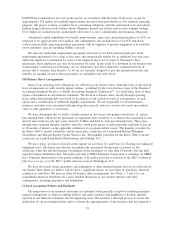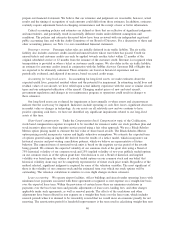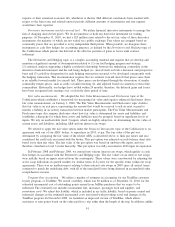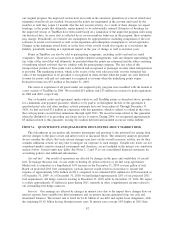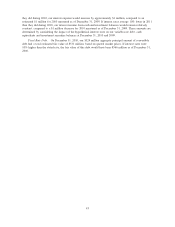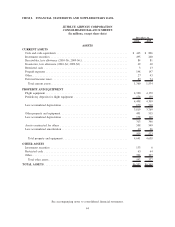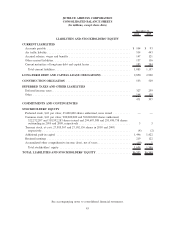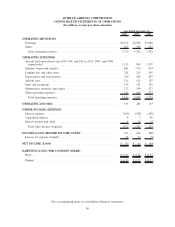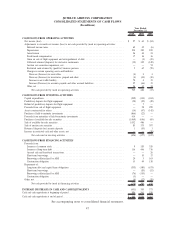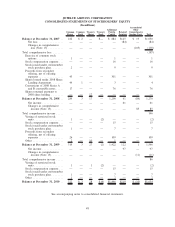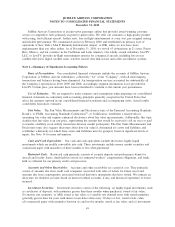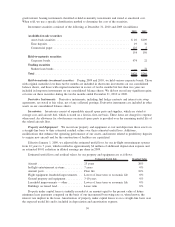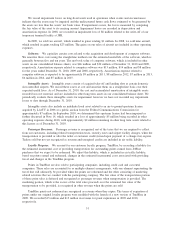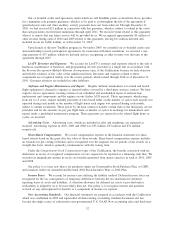JetBlue Airlines 2010 Annual Report Download - page 51
Download and view the complete annual report
Please find page 51 of the 2010 JetBlue Airlines annual report below. You can navigate through the pages in the report by either clicking on the pages listed below, or by using the keyword search tool below to find specific information within the annual report.our original program, the improved version does not result in the automatic generation of a travel award once
minimum award levels are reached, but instead the points are maintained in the account until used by the
member or until they expire 12 months after the last account activity. As a result of these changes we expect
breakage, or the points that ultimately expire unused, to be substantially reduced. Estimates of breakage for
the improved version of TrueBlue have been made based on a simulation of the improved program rules using
our historical data. As more data is collected by us on our members behaviors in the program, these estimates
may change. Periodically, we evaluate our assumptions for appropriateness, including comparison of the cost
estimates to actual costs incurred as well as the expiration and redemption assumptions to actual experience.
Changes in the minimum award levels or in the lives of the awards would also require us to reevaluate the
liability, potentially resulting in a significant impact in the year of change as well as in future years.
Points in TrueBlue can also be sold to participating companies, including credit card and car rental
companies. These sales are accounted for as multiple-element arrangements, with one element representing the
fair value of the travel that will ultimately be provided when the points are redeemed and the other consisting
of marketing related activities that we conduct with the participating company. The fair value of the
transportation portion of these point sales is deferred and recognized as passenger revenue when transportation
is provided. The marketing portion, which is the excess of the total sales proceeds over the estimated fair
value of the transportation to be provided, is recognized in other revenue when the points are sold. Deferred
revenue for points sold and not redeemed is recognized as revenue when the underlying points expire.
Deferred revenue was $57 million at December 31, 2010.
The terms of expiration of all points under our original loyalty program were modified with the launch of
a new version of TrueBlue in 2009. We recorded $15 million and $13 million in revenue for point expirations
in 2009 and 2010, respectively.
Our co-branded credit card agreement, under which we sell TrueBlue points as described above, provides
for a minimum cash payment guarantee, which is to be paid to us throughout the life of the agreement if
specified point sales and other ancillary activity payments have not been achieved. Through December 31,
2010, we had received $21 million in connection with this guarantee, which is subject to refund in the event
that cash payments exceed future minimums through April 2011. We record revenue related to this guarantee
when the likelihood of us providing any future service is remote. During 2010, we recognized approximately
$5 million related to this guarantee, leaving $11 million deferred and included in our air traffic liability.
ITEM 7A. QUANTITATIVE AND QUALITATIVE DISCLOSURES ABOUT MARKET RISK
The risk inherent in our market risk sensitive instruments and positions is the potential loss arising from
adverse changes to the price of fuel and interest rates as discussed below. The sensitivity analyses presented
do not consider the effects that such adverse changes may have on the overall economic activity, nor do they
consider additional actions we may take to mitigate our exposure to such changes. Variable-rate leases are not
considered market sensitive financial instruments and, therefore, are not included in the interest rate sensitivity
analysis below. Actual results may differ. See Notes 1, 2 and 13 to our consolidated financial statements for
accounting policies and additional information.
Aircraft fuel. Our results of operations are affected by changes in the price and availability of aircraft
fuel. To manage the price risk, we use crude or heating oil option contracts or jet fuel swap agreements.
Market risk is estimated as a hypothetical 10% increase in the December 31, 2010 cost per gallon of fuel.
Based on projected 2011 fuel consumption, such an increase would result in an increase to aircraft fuel
expense of approximately $130 million in 2011, compared to an estimated $101 million for 2010 measured as
of December 31, 2009. As of December 31, 2010, we had hedged approximately 28% of our projected 2011
fuel requirements. All hedge contracts existing at December 31, 2010 settle by December 31, 2012. We expect
to realize approximately $3 million in gains during 2011 currently in other comprehensive income related to
our outstanding fuel hedge contracts.
Interest. Our earnings are affected by changes in interest rates due to the impact those changes have on
interest expense from variable-rate debt instruments and on interest income generated from our cash and
investment balances. The interest rate is fixed for $1.61 billion of our debt and capital lease obligations, with
the remaining $1.42 billion having floating interest rates. If interest rates average 10% higher in 2011 than
42


